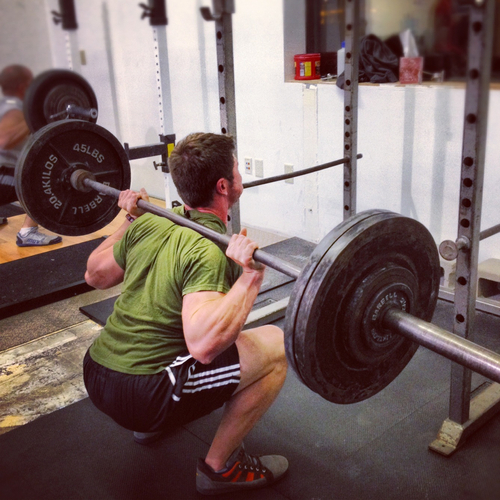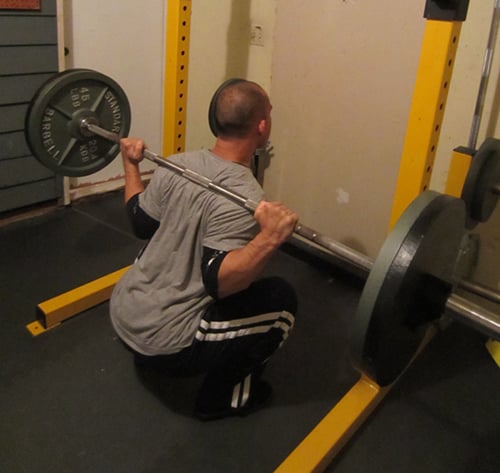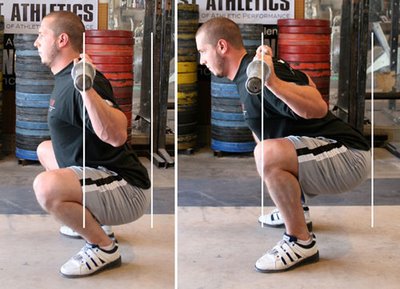The Squat is one of the toughest and most rewarding exercises you can do. If performed regularly and correctly, it can rapidly transform your legs and butt and build substantial core and lower back strength.
While many (most?) people neglect the Squat, a minority know its importance and hit it hard every week. And, based on the many emails and messages I get, many of those people eventually hit plateaus and aren’t sure how to break through them despite sound training programming and nutrition.
Well, in this article I want to share with you 7 effective ways to increase your squat. By utilizing one or more of these methods, you should be able to consistently add reps every week or two, which can then turn into adding weight.
Table of Contents
Want to listen to more stuff like this? Check out my podcast!
Tip #1 to Increase Your Squat:
Check Your Form
Like the Deadlift and Bench Press, improper form will not only kill your progress on the Squat, but will open you up to injury. On the other hand, perfecting your form will enable you to make steady progress with minimal setbacks.
Let’s take an in-depth look at proper form, as there’s quite a bit that goes into a proper Squat.
The Setup
There are two ways to set up for the squat:
- The high-bar position
- The low-bar position
A high-bar position has the bar resting directly on the upper traps, like this:

A low-bar position has the bar resting between the upper part of the traps and the rear deltoids, like this:

In the high-bar position, your torso will remain more upright during the squat than the low-bar position. Here’s a good illustration of this:
Both forms are correct but many people will find themselves stronger in the low-bar position because it’s more hip dominant (whereas the high-bar position is more knee dominant).That said, some people find the low-bar position very uncomfortable and naturally prefer the high-bar variant. Many people, myself included, find a happy medium.
The takeaway here is you should experiment with bar position to find what works best for you. It’s also smart to alternate between bar positions now and then, as improving your Squat in one will tend to help your performance in the other.
Once you have the bar position worked out, you’re ready to unrack the weight. Make sure your feet are directly under the bar so you can squat it off the pins, and make sure your chest is out and your shoulder blades pinched together.
After you unrack the bar, take a couple steps backward, place your feet between hip- and shoulder-width apart, and turn your feet about 15 to 20 degrees out. Keep your head in a neutral position, your elbows down and chest up, and take a deep breath.
You’re now ready to descend.
The Descent
Begin the descent by simultaneously pushing your hips back and breaking your knees (don’t consciously do one or the other first). You should feel some backward motion in your hips and the sensation that you’re sitting back onto your heels.
Keep your knees in line with and behind your toes (don’t let them collapse in or extend past your toes), and continue to sit down in between your hips. Your torso will naturally lean forward as you descend, but don’t exaggerate this–try not to exceed a 45-degree lean.
Sit down until your thighs are parallel or just below parallel to the ground, which you can see in this image shown earlier:

Once you reach this bottom position, you’re ready to ascend.
The Ascension
The key to starting a good ascent is driving through your heels and the middle of your feet, and ensuring that your shoulders move upward at the same rate as your hips.
As you continue to ascend, drive the hips forward by squeezing the glutes until you’re at the top of the rep.
Here’s a good video that summarizes all these points:
Tip #2 to Increase Your Squat:
Squat Heavy
The subject of “ideal” rep ranges is complex, so I won’t dive into it in this article. (I do talk a bit about it on my article on hypertrophy, though.)
Instead, I’ll keep this short and sweet:
If you’re new to weightlifting (you’ve been lifting for less than a year), you should be doing all squatting in the 4 to 6 rep range (guys) or 8 to 10 rep range (girls).
That means you use a weight that you can do at least 4 by not more than 6 reps with, and once you hit 6 reps, you add weight for the next set. If you want to see how this fits into an actual workout, check out my article on the ultimate legs workout.
If you’re an experienced weightlifter, you can benefit from working in different rep ranges, or periodizing your training.I will be discussing periodization in more detail in my next book, Beyond Bigger Leaner Stronger (which will be out in a month or two), and will be sharing a full periodized program for advanced lifters, but here’s a simple way to go about it for your squatting:
Week 1′s Squats: 2 sets of 2 to 3 reps (~90% of 1RM) + 1 sets of 4 to 6 reps (~80% of 1 RM) + 1 set of 8 to 10 reps (~70% of 1RM)
Week 2′s Squats: 2 sets of 2 to 3 reps + 2 sets of 4 to 6 reps + 1 set of 8 to 10 reps
Week 3′s Squats: 2 sets of 2 to 3 reps + 3 sets of 4 to 6 reps + 1 set of 8 to 10 reps
Week 4′s Squats: 2 sets of 2 to 3 reps + 3 sets of 4 to 6 reps + 1 set of 8 to 10 reps
Week 5′s Squats: 2 sets of 2 to 3 reps + 2 sets of one-rep max
As you can see, the above program has you squatting once per week (per 5 to 7 days), and involves working in the 2 to 3 range, which provides maximal overload, in the 4 to 6 rep work is the “sweet spot” for myofibrillar muscle growth, and in the 8 to 10 rep range, which is to stimulate growth via metabolic stress and cellular fatigue.
Once you’ve finished the 5-week cycle, you should deload for a week (or take a week off the weights), after which you can start again from week 1.
Tip #3 to Increase Your Squat:
Squat Deep Even If That Means Dropping the Weight
This was touched on in the first tip on form, but it deserves its own section.
The bottom line is if you’re not at least reaching parallel in your squatting, you’re cheating yourself. This has been part of the collective gymlore for years, but it’s backed by quite a bit of research:
- The deeper you squat, the more your legs will improve in both size and strength (yeah, it’s really that simple).
- The deeper you squat, the more your glutes are activated.
- The deeper you squat, the more your hips take the load off your knees.
- The deeper you squat, the more your lower back is strengthened.
- The deeper you squat, the more force you’ll be able to generate with your legs (which is particularly relevant to athletes).
I could go on, but that gives a pretty comprehensive list of reason why you need to be getting deep in your squats. How deep, though?
While there are benefits to the Full Squat, or “Ass to Grass Squat,” it requires quite a bit of mobility and flexibility, which we’re going to talk about next. I recommend you start with the Parallel Squat and build your strength up there before including the Full Squat in your leg workouts.
Tip #4 to Increase Your Squat:
Improve Your Lower-Body Mobility
While many people don’t realize how important proper form and depth is in the Squat, many of them couldn’t do it properly even if they wanted to. They simply lack the flexibility and mobility.
The most common problems are tight hips and hamstrings, but the ankles and calves often give people trouble as well. Fortunately, you can do a series of simple exercises to limber up and enable yourself to squat correctly with ease.
To learn more about this, check out my articles on how to improve lower body mobility and foam roller exercises that improve performance.
Tip #5 to Increase Your Squat:
Use the Right Shoes
Believe it or not, the wrong shoes can make squatting significantly harder.
A good weightlifting shoe does a few things:
- It provides a stable surface to help us balance and support heavy loads. This is particularly important with exercises like the deadlift, squat, and overhead press.
- It fits your feet snugly and leaves no wiggle room. You don’t want your feet moving around in your shoes as you train.
- It provides good traction so your feet don’t slip or shift during a lift.
The right weightlifting shoes not only improve your performance of important lifts like the squat and deadlift but they reduce the risk of injury as well.
Check out this article to see my weightlifting shoe recommendations.
Tip #6 to Increase Your Squat:
Do “Hold” Reps
The portion of the Squat that gives people the most trouble is getting out of the bottom. It requires an immense amount of force from and coordination between many muscles in the body.
It doesn’t have to haunt us though–we can actually focus on it in our training and turn it into a strong point. We do this by performing “Hold Reps.”
These are very simple to do: You squat like normal, but once you reach the bottom, you hold the position for 5 to 7 seconds, taking full, deep breaths, and then stand up.
This is not only a great way to train the glutes, hamstrings, and hip muscles that drive you up and out of the bottom of the Squat, it also greatly increases core strength and stability.
To get the most out of Hold Reps, I recommend you start with about 60% of your 1RM (weight that you would normally get 10 to 12 reps with) and work up to performing them with about 75 to 80% of your 1RM (weight that you would normally get 6 to 8 reps with).
In terms of how to work them into a workout, I prefer adding them after my normal heavy sets. I don’t replace my heavy 2 to 3 or 4 to 6 rep sets with Holds–I add a couple sets of Hold Reps after.
Tip #7 to Increase Your Squat:
Get Pumped Up
If you an experienced weightlifter, you know the importance of being mentally prepared for heavy lifts. You can psych yourself out or up and hit or miss a lift accordingly.
You’ve undoubtedly seen powerlifters go through what sometimes looks like a ridiculous, satanic ritual before attempting a lift, but did you know that pumping yourself up like that has been scientifically proven to work?
A study conducted by researchers at AUT University with elite rugby players found that when they pumped themselves up for a Bench Press set, force production increased by 8%. Researchers also found that distraction significantly decreased force production–there was a 12% difference in force production between the pumped-up and distracted lifters.
The takeaway here is pump yourself up your for heavy lifts and concentrate on each rep as your perform it–no talking, being talked to, or mental wandering.
I don’t stomp around the gym like a madman to get pumped up. I find that the right workout songs helps dramatically for getting pumped up, and before I grab the bar, I like to take 10 to 15 seconds to focus on the lift I’m about to perform and visualize myself performing it successfully. Sounds silly? Research has shown that visualizing a successful lift before performing it can increase strength.
What do you think about these tips on how to increase your squat? Have anything else to share? Let me know in the comments below!
+ Scientific References
- Richter J, Gilbert JN, Baldis M. Maximizing Strength Training Performance Using Mental Imagery. Strength Cond J. 2012;34(5):65-69. doi:10.1519/SSC.0b013e3182668c3d
- Argus CK, Gill ND, Keogh JWL, Hopkins WG. Acute effects of verbal feedback on upper-body performance in elite athletes. J Strength Cond Res. 2011;25(12):3282-3287. doi:10.1519/JSC.0b013e3182133b8c
- Sato K, Fortenbaugh D, Hydock DS. Kinematic changes using weightlifting shoes on barbell back squat. J Strength Cond Res. 2012;26(1):28-33. doi:10.1519/JSC.0b013e318218dd64









